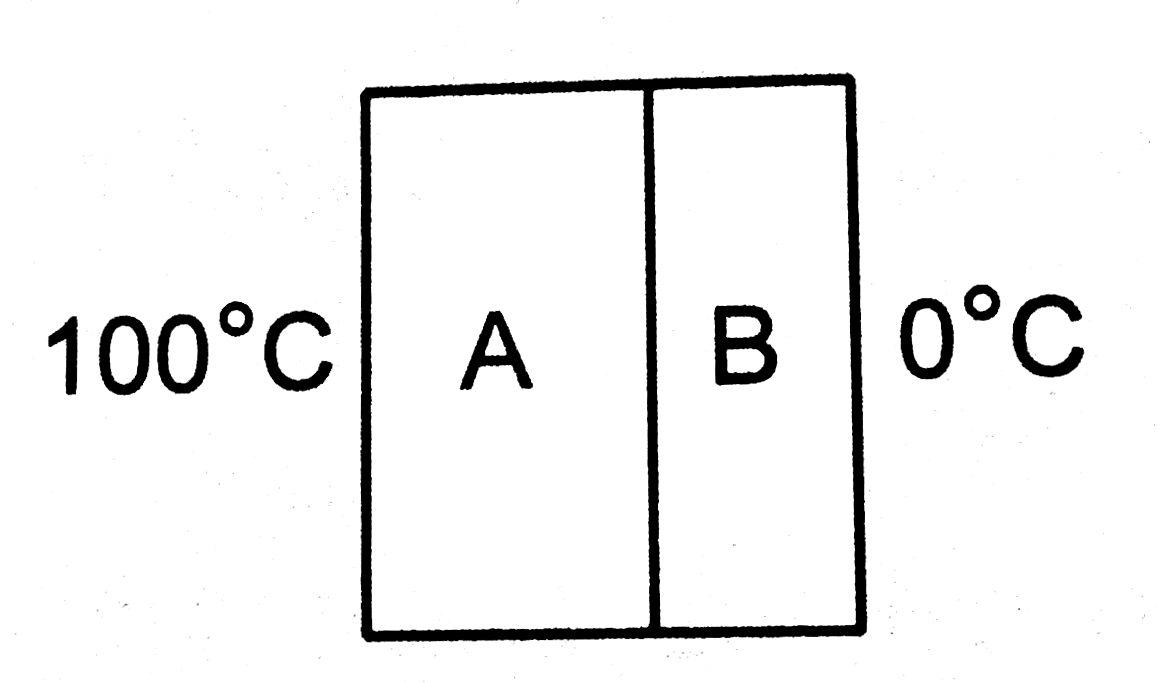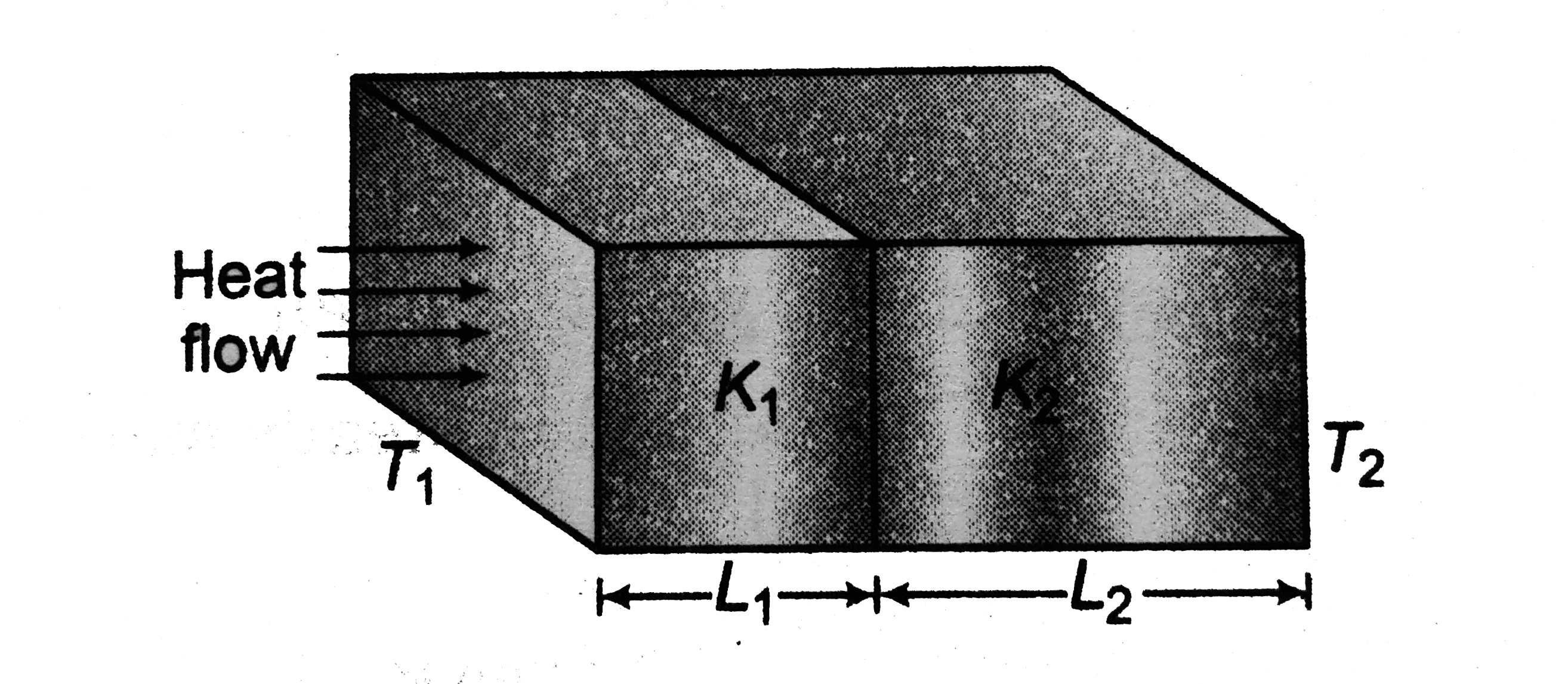Two parallel plates A and B are joined together to form a compound plate . The thicknesses of the plate are 4.0cm and 2.5cm respectively and the area of cross section is 100cm2 for each plate. The thermal conductivities are KA=200Wm−1C−1 for plate A and KB=400Wm−1C−1 for the plate B. The outer surface of the plate A is maintained at100∘C and the outer surface of the plate B is maintained at 0∘C. Find (a) the rate of heat flow through any cross section, (b) the temperature at the interface and (c) the equivalent thermal conductivity of the compound plate.

Let the temperature of the interface be theta. The area of cross section of each plate is A=100cm2=0.01m2 .The thicknesses are x_(A)=0.004mandx_(B)=0.025m.
The thermal resistance of the plate A is R1=1KAxAA .and that of the plate B is R2=1KBxBA . The equivalent thermal resistance is
R=R_(1)+R_(2)=(x_(A)/K_(A)+x_(B)/(K_(B))).thus,(DeltaQ)/(Deltat)=(theta_(1)-theta_(2))/(R).=(Atheta_(1)-theta_(2))/(x_(A)//K_(A)+x_(B)//K_(B)).((0.01m^(2))((100^(@)C)))/((0.04m)//(200Wm^(-1)^(∘)C−1)+(0.025m)/(400Wm−1^(@)C^(-1))).=3810W.(b)Wehave(DeltaQ)/(Deltat)=(A(theta-theta_(2)))/(x_(B)//K_(B)).or,3810W=((0.01m^(2))(theta-0^(@)C))/((0.025m)(200Wm^(-1)^(∘)C−1)+(0.025m)/(400Wm−1^(@)C^(-1))).or,theta=24^(@)C.(c)IfKisthe≡a≤ntthermalconductivityofthecompoundplate,itsthermalresistanceis<br>R=(1)/(A)(x_(A)+x_(B))/(K).Compar∈gwith(i)(x_(A)+x_(A))/(K)=(x_(A))/(K_(A))+x_(B)/(K_(B)).or,K=(x_(A)+x_(B))/(x_(A)//K_(A)+x_(B)//K_(B)).=248Wm^(-1)^(∘)C−1 .
Topper's Solved these Questions
- HEAT TRANSFERBOOK - HC VERMA ENGLISHCHAPTER - HEAT TRANSFEREXERCISE - OBJECTIVE I
10 Videos
- HEAT TRANSFERBOOK - HC VERMA ENGLISHCHAPTER - HEAT TRANSFEREXERCISE - OBJECTIVE II
6 Videos
- HEAT TRANSFERBOOK - HC VERMA ENGLISHCHAPTER - HEAT TRANSFEREXERCISE - QUESTIONS FOR SHORT ANSWER
11 Videos
- HEAT AND TEMPERATUREBOOK - HC VERMA ENGLISHCHAPTER - HEAT AND TEMPERATUREEXERCISE - Objective 2
6 Videos
- INTRODUCTION TO PHYSICSBOOK - HC VERMA ENGLISHCHAPTER - INTRODUCTION TO PHYSICSEXERCISE - Question for short Answer
4 Videos
Similar Questions
Two plates of equal area are placed in contact with each other. The thickness of the plates are 2.0 cm and 3.0 cm respectively. The outer face of first plate is at −25∘C and that of second plate is at +25∘C. The conductivities of the plates are in the ratio 2:3. Calculate the temperature of the common surface of the plates.
View SolutionTwo plates of equal area are placed in contact with each other. The thickness of the plates are 2.0 cm and 3.0 cm respectively. The outer face of first plate is at −25∘C and that of second plate is at +25∘C. The conductivities of the plates are in the ratio 2:3. Calculate the temperature of the common surface of the plates.
View Solution
Knowledge Check
IF two metallic plates of equal thickness and thermal conductivities K1andK2 are put together face to face anda common plate is constructed, then the equivalent thermal conductivity of this plate will be
AK1K2K1+K2B2K1K2K1+K2C(K21_K22)3/2K1K2D(K21+K22)3/22K1K2
A plate has a length (5±0.1) cm and breadth (2±0.01) cm . Then the area of the plate is
View SolutionThe length and breadth of a plate are (6±0.1)cmand(4±0.2)cm respectively. The area of the plate is
View SolutionTwo plates eachb of area A, thickness L1andL2 thermal conductivities K1andK2 respectively are joined to form a single plate of thickness (L1+L2). If the temperatures of the free surfaces are T1andT2. Calculate.

(a) rate of flow of heat
(b) temperature of interface and
(c) equivalent thermal conductivity.
View SolutionTwo identical plates of different metals are joined to form a single plate whose thickness is double the thickness of each plate. If the coefficients of conductivity of each plate are 2 and 3 respectively, Then the conductivity of composite plate will be
View SolutionTwo plates of equal areas are placed in contact wih each other. Their thickness are 2.0 cm and 5.0 cm respectively. The temperature of the external surface of the first plate is −20∘C and that of the external surface of the second plate is 20∘C. What will be the temperature of the current surface if the plates (i) are of the same material, (ii) have thermal conductivities in the ratio 2:5.
View SolutionA composite slab is prepared by pasting two plates of thickness L1 and L2 and thermal conductivities K1 and K2 . The slab have equal cross-sectional area. Find the equivalent conductivity of the composite slab.
View SolutionTwo identical plates with thermal conductivities K and 3K are joined together to form a single plate of double thickness. The equivalent thermal conductivity of one composite plate so formed for the flow of heat through its thickness is.
View Solution
